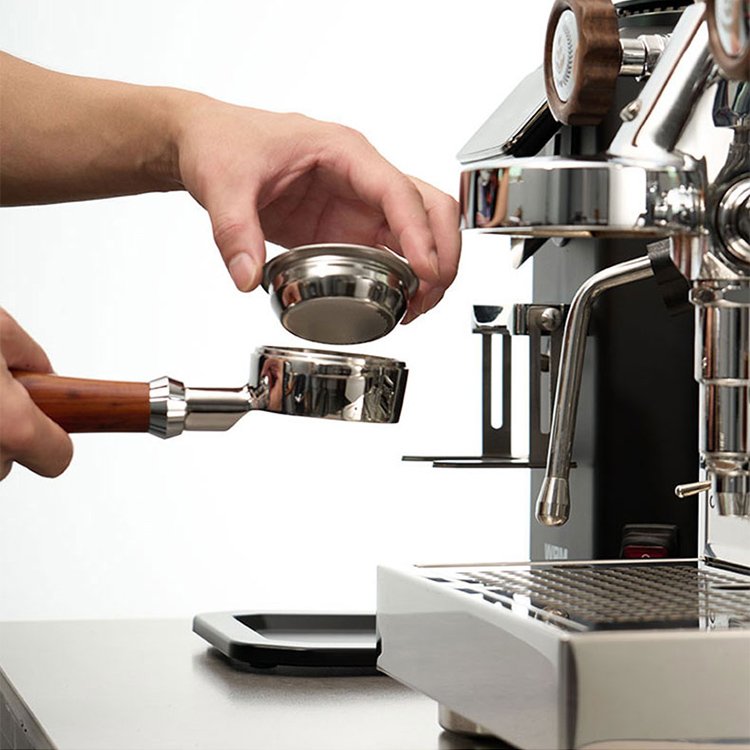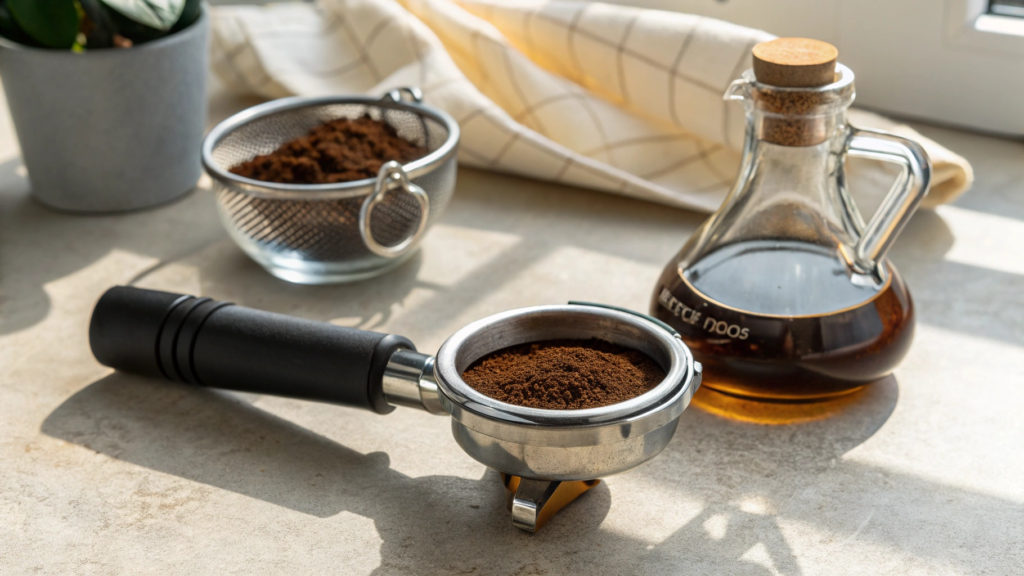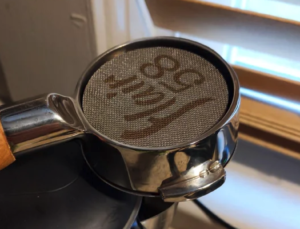Is your espresso tasting a bit off lately? You might be surprised that a dirty portafilter basket is often the secret problem causing bad coffee and headaches for baristas.
The best way to clean your portafilter basket is simple: rinse it under hot water immediately after each use. For deeper cleaning, occasionally soak it in a dedicated coffee equipment cleaner. This keeps the holes clear and prevents old oils from ruining your espresso's taste.

Keeping your coffee equipment clean is really important, maybe more than you think. It's not just about looks; it directly impacts the taste of every single shot you pull. For businesses supplying coffee shops, like many of my clients in Dubai, consistent quality is everything. Let's look deeper into how to keep these essential tools in top shape.
How do you clean a portafilter basket properly?
Struggling with stubborn coffee residue in your basket? Worried about damaging the precision holes while cleaning? Getting it truly clean is easier than you think with the right steps.
Quickly rinse the basket with hot water after pulling a shot. Use a brush for stuck grounds. For a deep clean, soak weekly (or daily for busy cafes) in espresso machine cleaner like Cafiza or Puly Caff, then rinse very well.

Daily Rinse vs. Deep Soak
Cleaning your portafilter basket isn't a one-size-fits-all task. There are really two main parts to keeping it perfect: the quick daily clean and the more thorough deep clean.
1. Daily Cleaning Routine:
Think of this as basic hygiene for your espresso setup. After every shot:
- Knock out the used coffee puck immediately. Don't let it sit.
- Rinse the basket thoroughly under hot water from the espresso machine's group head or a tap. Hot water helps dissolve oils.
- Use a soft brush (like a group head brush)1 to gently scrub away any remaining coffee grounds, especially around the inside edge and the bottom holes.
- Give it a final rinse.
- Wipe it dry with a clean microfiber cloth before locking it back into the group head or storing it. This quick process takes maybe 15-20 seconds but makes a huge difference. From my experience manufacturing these baskets at SIF Coffee Tools, keeping those precision holes clear is vital for even extraction.
2. Periodic Deep Cleaning:
Coffee oils build up over time, even with daily rinsing. These oils turn rancid and create bitterness. A deep clean removes this buildup.
- Frequency: For a busy cafe, do this daily. For moderate home use, weekly is often enough. High-volume home users might do it more often.
- Method: Dissolve a teaspoon of espresso machine cleaning powder2 (Cafiza, Puly Caff, etc.) in hot water in a small container. Don't use dish soap – it leaves residue. Remove the basket from the portafilter handle (you might need to pry it out gently). Soak only the metal basket in the solution for 15-30 minutes. You'll see the water turn brown as oils dissolve. Avoid soaking the handle, especially if it's wood or plastic.
- Rinsing: This is critical. Rinse the basket very thoroughly under running water. Any leftover cleaner will make your coffee taste awful.
- Drying: Dry completely before use.
This two-step approach ensures your baskets perform like new, delivering consistent, delicious espresso.
| Cleaning Type | Frequency | Method | Purpose |
|---|---|---|---|
| Daily Rinse | After every shot | Hot water rinse, gentle brush, wipe dry | Remove fresh grounds, light oils |
| Deep Soak | Daily (Cafe) / Weekly (Home) | Soak in coffee cleaner solution, rinse well | Remove built-up oils, prevent clogging |
How often should I clean my portafilter?
Are you unsure how often cleaning is truly needed? Over-cleaning feels like a waste of time, but under-cleaning ruins coffee. Let's find the right balance for perfect espresso.
You should rinse your portafilter basket after every single shot. A deeper clean with a coffee-specific detergent should happen daily in a commercial setting or at least weekly for regular home use to remove built-up oils.

Finding Your Cleaning Rhythm
The ideal cleaning frequency3 isn't set in stone; it depends heavily on how much you use your machine and a couple of other factors. Getting this right is key for taste consistency, something my B2B clients like Muhammad Murat in the UAE value highly for their distribution networks.
Factors Influencing Cleaning Frequency:
- Volume of Use: This is the biggest factor.
- High Volume (Busy Cafe): Daily deep cleaning is essential. Sometimes even mid-day backflushing and basket swaps are needed. Rinsing after every shot is non-negotiable.
- Medium Volume (Office, Prosumer Home): A weekly deep clean is usually sufficient, combined with rinsing after every use.
- Low Volume (Occasional Home Use): Rinsing after each use is still important. A deep clean might only be needed every 2-4 weeks, but don't leave it too long, as oils can still build up and go stale.
- Coffee Type: Darker roasts tend to be oilier than lighter roasts. If you primarily use oily beans, you might need to deep clean more frequently as the oils build up faster.
- Water Hardness: While less critical for the basket itself compared to the machine's internals, hard water can sometimes contribute to scale build-up if baskets aren't dried properly, potentially blocking micro-holes over time. Using filtered water helps generally.
- Your Standards: If you're aiming for the absolute best flavour profile every time, more frequent cleaning is always better.
Why Consistency Matters for Business:
For distributors supplying cafes, ensuring their customers understand proper cleaning schedules is part of providing value. A cafe using baskets supplied by SIF Coffee Tools needs consistent performance. If their cleaning is inconsistent, the espresso quality drops, which might unfairly reflect on the equipment. Providing simple cleaning guidelines can prevent this. My insight is simple: always clean the basket after use. Letting coffee dry inside is the fastest way to block those tiny, crucial holes.
Simple Guideline Table:
| Usage Level | Rinse | Deep Clean Frequency | Notes |
|---|---|---|---|
| Cafe (High Vol) | After Each Shot | Daily | Consider mid-day swaps/cleaning too |
| Office (Med Vol) | After Each Shot | Weekly | Monitor oil buildup |
| Home (Regular Use) | After Each Shot | Weekly - Bi-Weekly | Adjust based on bean type |
| Home (Occasional) | After Each Shot | Monthly | Don't let oils sit too long |
Can I clean a portafilter with vinegar?
Thinking about using household vinegar for a cheap clean? Concerned it might damage your equipment or leave a weird taste? Let's clear up if this common kitchen cleaner is suitable.
No, you should not use vinegar to clean your portafilter basket. Vinegar's acidity can potentially damage the metal finish or leave unwanted odors and tastes that will transfer to your coffee. Stick to specialized coffee equipment cleaners.

Why Vinegar Isn't the Right Choice
Vinegar is often suggested as a do-it-all household cleaner, and it's great for some things, but your coffee equipment isn't one of them. While it might seem like a simple, readily available option, using it on portafilter baskets (or most coffee gear) comes with significant downsides.
1. Ineffectiveness Against Coffee Oils:
The main enemy in a dirty portafilter basket is coffee oil build-up. These oils become sticky and rancid over time. Vinegar, being an acid (acetic acid), is effective at breaking down mineral scale (like limescale) but is not very good at dissolving oils. Dedicated coffee cleaners contain detergents (alkaline compounds) specifically designed to break down and lift away these coffee oils and residues. Vinegar simply won't clean as thoroughly.
2. Potential Material Damage:
Portafilter baskets, especially high-quality ones like the precision-engineered baskets we make at SIF Coffee Tools, are often made of stainless steel. While stainless steel is resistant to corrosion, prolonged exposure to acids like vinegar, especially if not rinsed extremely well, could potentially etch or tarnish the surface over time. Cheaper baskets with chrome plating are even more susceptible to acid damage, which can cause pitting or flaking.
3. Odor and Taste Transfer:
Vinegar has a very strong, distinct smell and taste. Even after thorough rinsing, trace amounts can linger on the metal surface or within the micro-holes of the basket. This residue will definitely transfer to your next brew, resulting in unpleasantly sour or vinegary espresso. Coffee cleaners are formulated to rinse away cleanly without leaving any taste or odor.
4. Manufacturer Recommendations:
Most espresso machine and accessory manufacturers specifically advise against using vinegar for cleaning components like portafilters and baskets. They recommend using designated coffee equipment cleaners that are tested and proven safe and effective for the materials used. Using vinegar could potentially void warranties in some cases.
Stick to the Right Tools:
Using a proper cleaner like Cafiza, Puly Caff, or Urnex products ensures effective cleaning without risking damage or taste contamination. For our clients who demand premium quality and reliability, using the correct cleaning agents is part of maintaining that standard. It's just not worth the risk to use vinegar.
Is it bad to leave coffee in portafilter?
Finished brewing and feel tempted to leave the spent puck? Wondering if it really harms anything to clean it later? Letting used coffee sit is a surprisingly bad habit.
Yes, it is bad to leave the used coffee puck in the portafilter. The moist grounds dry out, harden, and stick inside the basket, making it much harder to clean later and potentially clogging the tiny filter holes.

The Problem with Procrastinating Cleanup
Leaving the wet coffee grounds sitting in the portafilter basket after pulling a shot is a common shortcut, especially when you're in a rush. However, this seemingly small act of procrastination causes several problems that impact both your equipment and your coffee quality.
1. Drying and Hardening:
Freshly brewed coffee grounds are wet and relatively easy to knock out. As they sit in the basket, the water evaporates. The grounds dry out, shrink slightly, and compact together. Coffee oils also start to solidify as they cool. This combination makes the puck much harder and more stubborn to remove later. You often end up needing to scrape or dig it out, which risks scratching or damaging the fine filter holes.
2. Clogging the Filter Holes:
This is the most critical issue, especially for precision baskets like ours at SIF Coffee Tools. As the grounds dry, fine particles and oils get drawn into the tiny holes by capillary action. When they harden there, they create blockages. Even partial blockages disrupt the even flow of water during subsequent extractions. This leads to channeling (where water punches through weak spots in the puck) and uneven extraction, resulting in poor-tasting espresso – often sour and bitter simultaneously. My personal insight is clear: clogged holes are the enemy of good espresso. Cleaning immediately prevents this entirely.
3. Stale Flavors and Odors:
Coffee oils begin to degrade and go rancid fairly quickly once exposed to air and temperature changes. Leaving the spent puck allows these stale, rancid compounds to sit in contact with the metal basket. These flavors can subtly infuse into the metal and taint future shots, contributing to a muddy or stale taste profile.
4. Increased Cleaning Effort:
What takes 5 seconds immediately after brewing (knock and rinse) can turn into a minute or more of scraping and scrubbing if you let the puck dry. Over time, this repeated difficulty encourages less thorough cleaning, leading to faster buildup of residues.
Establishing a Good Habit:
Making it an automatic reflex to knock out the puck and rinse the basket immediately after brewing is one of the simplest yet most effective things you can do to maintain coffee quality and equipment longevity. It prevents blockages, avoids stale flavors, and makes your overall cleaning routine much easier. For businesses relying on consistent output, this non-negotiable step saves time and ensures quality in the long run.
How will espresso taste if it is made with dirty portafilter?
Noticing inconsistent or unpleasant espresso flavors? Wondering if your cleaning habits are the hidden reason? A dirty portafilter basket absolutely ruins the taste of your coffee.
Espresso made with a dirty portafilter basket will taste bad. Expect flavors that are excessively bitter, rancid, sour, or generally stale and muddy. The old, built-up coffee oils and grounds directly contaminate the new brew.

The Taste Impact of Poor Hygiene
The connection between a clean portafilter basket and delicious espresso is direct and undeniable. When you neglect cleaning, you introduce several factors that actively spoil the flavor profile you're trying to achieve. For my clients like Muhammad Murat, supplying cafes across the UAE, ensuring end-users understand this is crucial for customer satisfaction with the products we supply.
1. Rancid Oil Contamination4:
Coffee beans contain natural oils. These oils are essential for crema and carry many aromatic compounds. However, once brewed and exposed to air and heat cycles in the portafilter, these oils quickly begin to oxidize and degrade. They become rancid. When you brew fresh coffee through a basket coated in old, rancid oils, those nasty flavors transfer directly into your cup. This usually translates to excessive, unpleasant bitterness or a taste often described as 'stale' or 'ashy'. I remember visiting a cafe once where the coffee was just terribly bitter; a quick look at their portafilters showed significant dark oil buildup.
2. Uneven Extraction from Clogged Holes5:
As discussed earlier, dried coffee grounds and solidified oils block the tiny precision holes in the basket. This prevents water from flowing evenly through the fresh coffee puck. Water will seek the path of least resistance, leading to:
- Channeling: Water jets through certain areas, over-extracting them (causing bitterness).
- Under-extraction: Other areas don't get enough water flow, leading to weak, sour flavors.
The resulting shot is unbalanced – a mix of sourness and bitterness, lacking the coffee's true sweetness and complexity. The beautiful shots seen in marketing rely on perfectly even flow, which requires perfectly clean holes.
3. Introduction of Old, Stale Grounds6:
Micro-particles of old coffee can remain lodged in the basket, even if it looks relatively clean. These stale grounds mix with the fresh brew, contributing muddy, dull, or papery flavors that mask the vibrant notes of your fresh beans.
Consistency is Key:
For anyone serious about coffee, from home enthusiasts to high-volume cafes, cleanliness equals consistency. A clean basket ensures that the only thing you are tasting is the fresh coffee you just brewed, extracted properly. It allows the grinder settings, dose, tamp, and beans to express themselves truly. At SIF Coffee Tools, we engineer our baskets for precision; maintaining that precision requires simple, regular cleaning. Dirty equipment introduces unwanted variables that make achieving consistently great espresso impossible.
Conclusion
Keeping your portafilter basket clean is simple but vital. Rinse it after every shot and deep clean regularly with proper solutions. Clean baskets mean delicious, consistent espresso every time.
-
Find out which soft brushes are recommended for maintaining your espresso machine, ensuring optimal performance and longevity. ↩
-
Explore this link to discover top-rated cleaning powders that ensure your espresso machine stays in peak condition, enhancing your coffee experience. ↩
-
Understanding the ideal cleaning frequency can enhance your coffee machine's performance and taste consistency, crucial for any coffee business. ↩
-
Understanding rancid oil contamination can help you improve your coffee brewing techniques and enhance flavor quality. ↩
-
Learn about the impact of clogged holes on coffee extraction to ensure a balanced and flavorful cup every time. ↩
-
Discover how old, stale grounds can ruin your coffee experience and how to avoid them for better flavor. ↩




